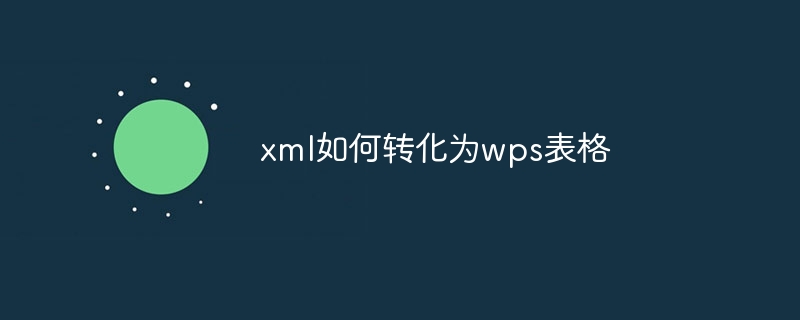How to convert XML to WPS table? Open a WPS table, select the Data tab and import the XML file. Configure import settings, including file type, delimiter, and data type. After completing the import, preview and modify the data.

How to convert XML to WPS tables
XML (Extensible Markup Language) is a markup language widely used to store and exchange data. WPS Form is a spreadsheet application that is widely used in data processing and analysis. This article will guide you on how to convert XML files to WPS tables.
Step 1: Open the WPS form
Start the WPS Form Application.
Step 2: Import XML data
Click the Data tab and select Import data from text/CSV/XML file.
Step 3: Select the XML file
In the Import Data dialog box, navigate to the XML file you want to convert, and then select it.
Step 4: Configure import settings
In the Import Data dialog box, select the following options:
- File Type: XML
- Delimiter: Select a separator (for example, a comma, semicolon, or space) that matches the separator used in the XML file.
- Data type: Select the appropriate data type (for example, text, number, or date) as needed.
Step 5: Import the data
Click OK to start the import process.
Step 6: Preview and modify the data
The imported data will be displayed in the WPS table. You can preview and modify it as needed.
hint:
- If the XML file has a complex structure, you may need to use the "XML Mapping" feature of the WPS table for more precise conversions.
- You can also use third-party tools such as Oxygen XML Editor to convert XML to another format before importing WPS tables.
The above is the detailed content of How to convert xml to wps table. For more information, please follow other related articles on the PHP Chinese website!

Hot AI Tools

Undress AI Tool
Undress images for free

Undresser.AI Undress
AI-powered app for creating realistic nude photos

AI Clothes Remover
Online AI tool for removing clothes from photos.

Clothoff.io
AI clothes remover

Video Face Swap
Swap faces in any video effortlessly with our completely free AI face swap tool!

Hot Article

Hot Tools

Notepad++7.3.1
Easy-to-use and free code editor

SublimeText3 Chinese version
Chinese version, very easy to use

Zend Studio 13.0.1
Powerful PHP integrated development environment

Dreamweaver CS6
Visual web development tools

SublimeText3 Mac version
God-level code editing software (SublimeText3)

Hot Topics
 XML Namespace: Coding Guide
Jun 20, 2025 am 12:09 AM
XML Namespace: Coding Guide
Jun 20, 2025 am 12:09 AM
The coding guide for XML namespaces includes: 1. Declare the namespace using the xmlns attribute, such as. 2. Use prefix to refer to the namespace, such as. 3. The namespace URI is a unique identifier, not a real URL. 4. When using the default namespace, all unprefixed elements belong to the namespace, such as. 5. Use tools such as XSD to verify and debug namespaces. 6. Maintain prefix consistency and document readability and provide necessary comments.
 Well-Formed XML: The Foundation for Valid XML
Jun 19, 2025 am 12:05 AM
Well-Formed XML: The Foundation for Valid XML
Jun 19, 2025 am 12:05 AM
XMLisconsideredwell-formedifitadherestospecificsyntacticrules.Theserulesinclude:1)everyopeningtagmusthaveacorrespondingclosingtag,2)attributesmustbeproperlyquoted,and3)elementsmustbeproperlynested.Ensuringwell-formednessisessentialforcreatingaunivers
 XML rules: Common errors to avoid
Jun 22, 2025 am 12:09 AM
XML rules: Common errors to avoid
Jun 22, 2025 am 12:09 AM
Methods to avoid XML errors include: 1. Ensure that the elements are nested correctly, 2. Escape special characters. Correct nesting avoids parsing errors, while escape characters prevent document corruption, using an XML editor can help maintain structural integrity.
 XML: Are Namespaces required?
Jul 01, 2025 am 12:05 AM
XML: Are Namespaces required?
Jul 01, 2025 am 12:05 AM
XMLnamespacesarenotalwaysrequired,buttheyareessentialincertainsituations.1)TheyhelppreventnameconflictsinXMLdocumentscombiningelementsfrommultiplesources.2)Theycanbeomittedinsmall,self-containeddocuments.3)Bestpracticesincludeusingmeaningfulprefixesa
 XML well formed vs Valid: A full comparison
Jun 21, 2025 am 12:07 AM
XML well formed vs Valid: A full comparison
Jun 21, 2025 am 12:07 AM
XML is called "well-formed" to refer to its basic syntax correctness, while "valid" requires it not only well-formed, but also to conform to a specific pattern or DTD. 1. Well-formedXML needs to follow XML specifications, such as correct nesting of elements and correct use of tags. 2. ValidXML must comply with the structure and content rules defined by the schema or DTD.
 XML Namespace: The most common Errors
Jun 27, 2025 am 01:00 AM
XML Namespace: The most common Errors
Jun 27, 2025 am 01:00 AM
XMLnamespacescancauseerrors,butthesecanberesolvedbyfollowingspecificsteps.1)Alwaysdeclarethenamespaceusingxmlnsattherootorwhereneeded.2)Ensureprefixesmatchthedeclarednamespaces.3)Useuniqueprefixesfordifferentnamespacestoavoidconflicts.4)Properlydecla
 XML: Which are the best alternatives?
Jul 01, 2025 am 12:12 AM
XML: Which are the best alternatives?
Jul 01, 2025 am 12:12 AM
JSON,YAML,ProtocolBuffers,CSV,andTOMLaresuitablealternativestoXML.1)JSONisidealforreadabilityandeaseofuse.2)YAMLofferscleanersyntaxandsupportscomments.3)ProtocolBuffersexcelinhigh-performanceapplications.4)CSVisperfectforsimpledataexchange.5)TOMLbala
 Why XML Is Still Relevant: Exploring Its Strengths for Data Exchange
Jul 05, 2025 am 12:17 AM
Why XML Is Still Relevant: Exploring Its Strengths for Data Exchange
Jul 05, 2025 am 12:17 AM
XMLremainsrelevantduetoitsstructuredandself-describingnature.Itexcelsinindustriesrequiringprecisionandclarity,supportscustomtagsandschemas,andintegratesdatavianamespaces,thoughitcanbeverboseandresource-intensive.






